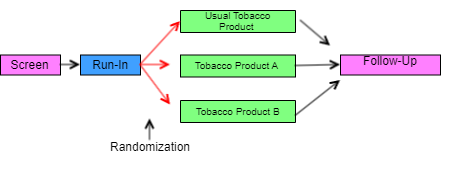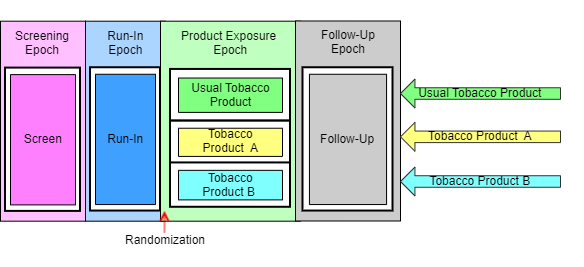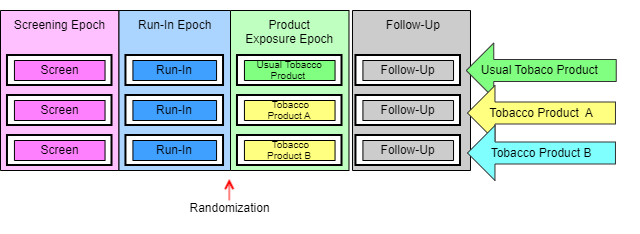Diagrams that represent study schemas generally conceive of time as moving from left to right, using horizontal lines to represent periods of time and slanting lines to represent branches into separate arms, convergence into a common follow-up, or crossover to a different product.
In this type of document, diagrams are drawn using "blocks" corresponding to trial elements rather than horizontal lines. Trial elements are the various time periods of the trial and might otherwise be "hidden" in a single horizontal line. See Section 3.3.1.1.3, Trial Elements (TE), for more information about defining trial elements. In general, the elements of a trial will be fairly clear. However, in the process of working out a trial design, alternative definitions of trial elements may be considered, in which case diagrams for each alternative may be constructed.
In the study schema diagrams in this example, the only slanting lines used are those that represent branches (i.e., decision points where subjects are divided into separate groups). One advantage of this style of diagram, which does not show convergence of separate paths into a single block, is that the number of arms in the trial can be determined by counting the number of parallel paths at the right end of the diagram.
As illustrated in the study schema diagram for Example Trial 1, this simple parallel trial has 3 arms, corresponding to the 3 possible left-to-right "paths" through the trial. Each path corresponds to 1 of the 3 elements at the right end of the diagram. Randomization is represented by the 3 red arrows leading from the Run-in block.

The next diagram for this trial shows the 4 epochs of the trial, indicates the 3 arms, and shows the sequence of elements for each group of subjects in each epoch. The arrows are at the right side of the diagram because it is at the end of the trial that all the separate paths through the trial can be seen. Note that, in this diagram, randomization—which was shown using 3 red arrows connecting the Run-in block with the 3 product exposure blocks in the first diagram—is indicated by a note with an arrow pointing to the line between 2 epochs.

The next diagram can be thought of as the retrospective view of a trial, the view back from a point in time when a subject’s assignment to an arm is known. In this view, the trial appears as a grid, with an arm represented by a series of study cells, one for each epoch, and a sequence of elements within each study cell. In this example (as in many trials), there is exactly 1 element in each study cell. In more complicated designs this is not always the case.

The next diagram shows the trial from the viewpoint of blinded participants. To blinded participants in this trial, all arms look alike. They know when a subject is in the screen element or the run-in element, but when a subject is in the product exposure epoch, participants know only that the subject is receiving a study product, not which study product, and therefore not which element.

A trial design matrix is a table with a row for each arm in the trial and a column for each epoch in the trial. It is closely related to the retrospective view of the trial, and many users may find it easier to construct a table than to draw a diagram. The cells in the matrix represent the study cells, which are populated with trial elements. In this trial, each study cell contains exactly 1 element.
As illustrated in the following table, the columns of a trial design matrix are the epochs of the trial, the rows are the arms of the trial, and the cells of the matrix (the study cells) contain elements. Note that randomization is not represented in the trial design matrix. All of the preceding diagrams and the trial design matrix are alternative representations of the trial design. None of them contains all the information that will be in the finished TA dataset; users may find it useful to draw some or all of these diagrams when working out the dataset.
Trial Design Matrix
| Screen | Run-in | Study Product Exposure | Follow-Up | |
|---|---|---|---|---|
| Usual Brand | Screen | Run-in | Usual Tobacco Product | Follow-Up |
| A | Screen | Run-in | Tobacco Product A | Follow-Up |
| B | Screen | Run-in | Tobacco Product B | Follow-Up |
For Example Trial 1, the conversion of the trial design matrix into the TA dataset is straightforward. For each cell of the matrix, there is a record in the TA dataset. ARM, EPOCH, and ELEMENT can be populated directly from the matrix. TAETORD acts as a sequence number for the elements within an arm, so it can be populated by counting across the cells in the matrix. The randomization information, which is not represented in the trial design matrix, is held in TABRANCH in the TA dataset. TABRANCH is populated only if there is a branch at the end of an element for the arm. When TABRANCH is populated, it describes how the decision at the branch point would result in a subject being in this arm. TATRANS is not used for this design but as it is an expected variable it is included in the datset.